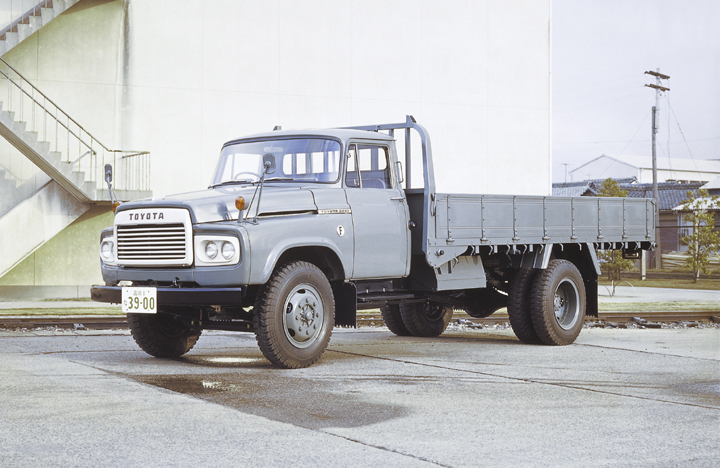Section 3. Development and Sales of New Models-Promotion of Comprehensive Product Lineup
Item 5. Development of New Trucks
As the 1960s rolled in and customer requirements became more diversified and sophisticated, Toyota, as a general automaker, also developed and introduced a range of trucks, from small to large.
In March 1959, Toyota redesigned the Toyoace truck. The new Toyoace (SK20) adopted an innovative style while retaining traces of the previous model.
For the chassis, Toyota reduced the number of front leaf springs and adopted a simple shock absorber to improve riding comfort. Furthermore, the P engine, which had been in development for some time, was installed in October of the same year to create the Toyoace PK20.
In May 1959, the cab-behind-engine-type Toyopet truck was nicknamed the Stout, while the cab-over type was nicknamed the Dyna. Subsequently, the Stout was redesigned into the RK45 in July 1960 and the Dyna was redesigned into the RK170 in March 1963, in both cases strengthening the chassis and improving comfort. Then in September 1963, Toyota also launched the Lite Stout (RK40) with a narrower wheelbase than the Stout.
In September 1964, Toyota redesigned its large-size trucks. The new trucks (FA100 and DA100) possessed dynamic styling in both exterior appearance and interior features suitable for the highway era, as well as further improved performance.
Due to transportation mode diversification and worsening traffic situations in cities, the demand for trucks subsequently began to shift to compact models with good maneuverability. Furthermore, as the passenger car share of the car market increased, customers began to desire a passenger car-like feel even in commercial trucks used mainly for transport.
In October 1967, Toyota launched the cab-over commercial vehicle, the Hiace. The Hiace (PH10) featured comfort and maneuverability levels similar to those of a passenger car and was offered in a wide variety of versions suitable to various purposes. Based on a delivery van platform, it was available in such forms as a 1-ton truck, a nine-seater version, and the Commuter 12-passenger and 15-passenger buses.
Toyota then launched the new Miniace (UP100 cab-over type), a small 500-kilogram truck, in November of the same year and the new Liteace (KM10 cab-over type) in November 1970.
As a model positioned between the Hiace and Miniace, the Liteace squarely met the market requirements, and its stable quality allowed its sales volume to increase steadily. The assembly of the Liteace was subcontracted to Toyota Auto Body Co., Ltd. and Daihatsu Motor and also went smoothly.
In March 1968, Toyota launched the Hilux (RN10). To enhance the 1-ton cab-behind-engine-type truck, Toyota combined the Lite Stout with the Briska, and subcontracted vehicle assembly to Hino Motors. Equipped with the 2R engine (1,500 cc), the Hilux offered numerous passenger car-like features, including innovative styling, the use of curved glass for the first time in a small truck, and a large comfortable cabin space. Toyota also put effort into exporting the Hilux, and in 1969 installed the 3R engine (1,900 cc) in a model meant for the U.S. market. The export volume steadily increased, helped by the Hilux's excellent performance, high quality, convenient size, and affordable price.
In February 1969, Toyota redesigned the 2-ton, cab-over Dyna. For the new Dyna models (RU10 and JU10), Toyota adopted completely new styling, enhanced the braking performance in line with the needs of driving in the highway era, and moved the front tires forward to improve ease of ingress and egress as well as comfort.
Toyota also improved the Toyota Light Bus, a popular vehicle in the Dyna series, and launched it as the Toyota Coaster (RU18 and JU18). Furthermore, in June of the same year, Toyota launched the 3-ton Dyna equipped with the H diesel engine.
In September 1969, Toyota launched the new 4-ton Massy Dyna (QC10). In designing the Massy Dyna, Hino Motors handled the engine, clutch, and transmission, Toyota Auto Body handled the cabin and rear deck, and Toyota handled the frame.






